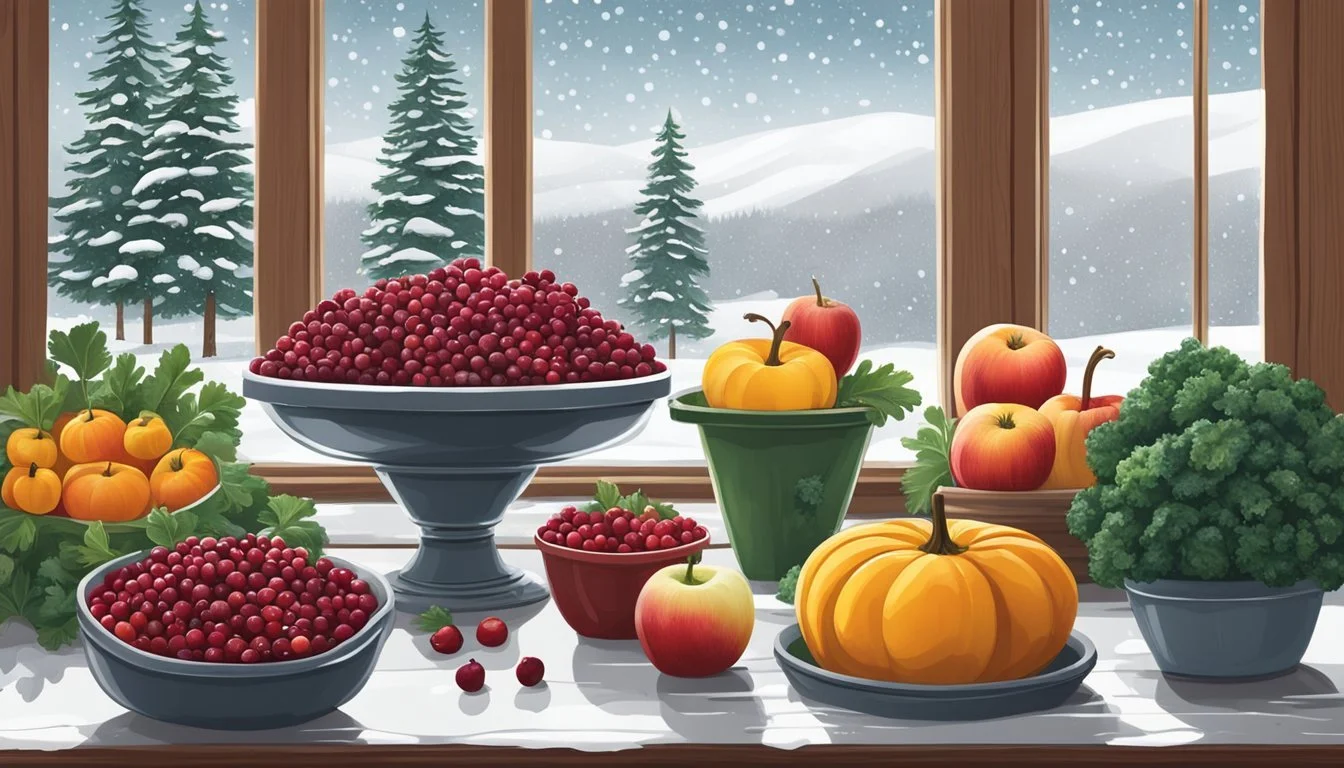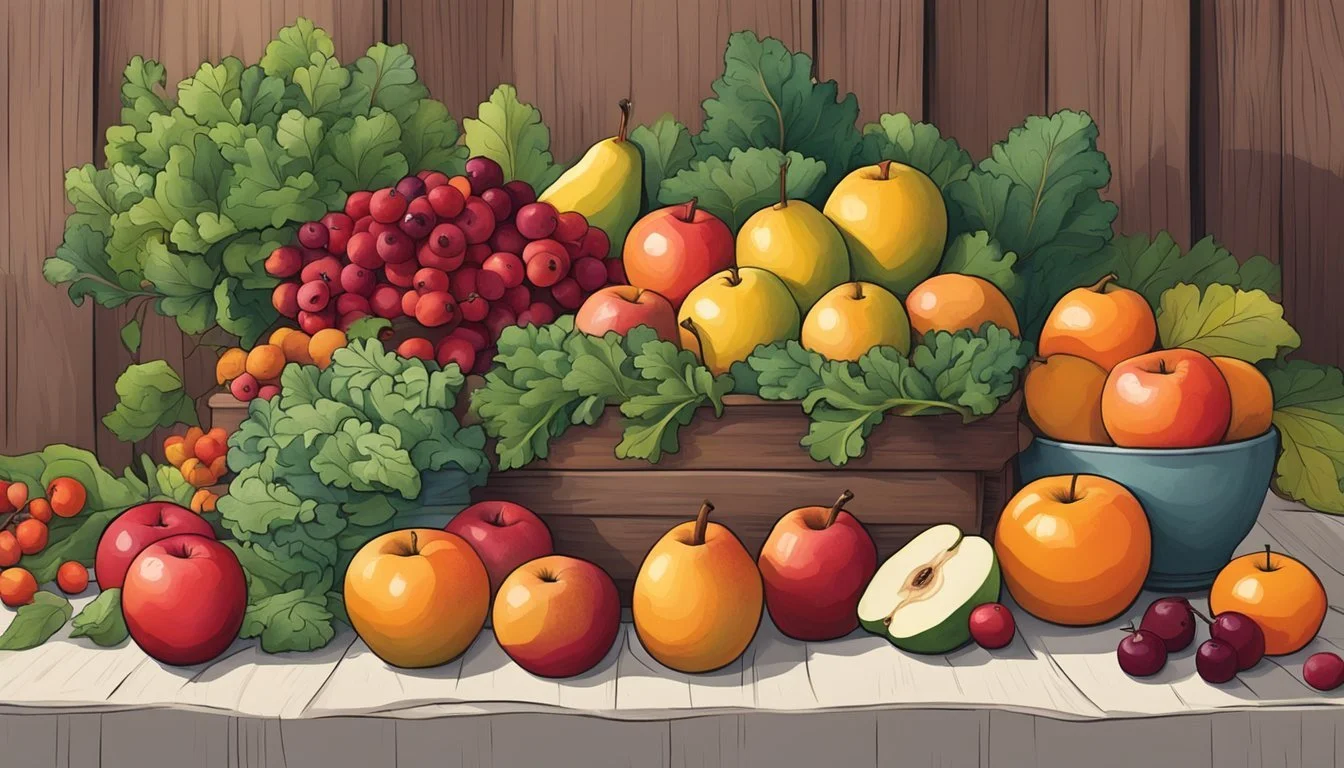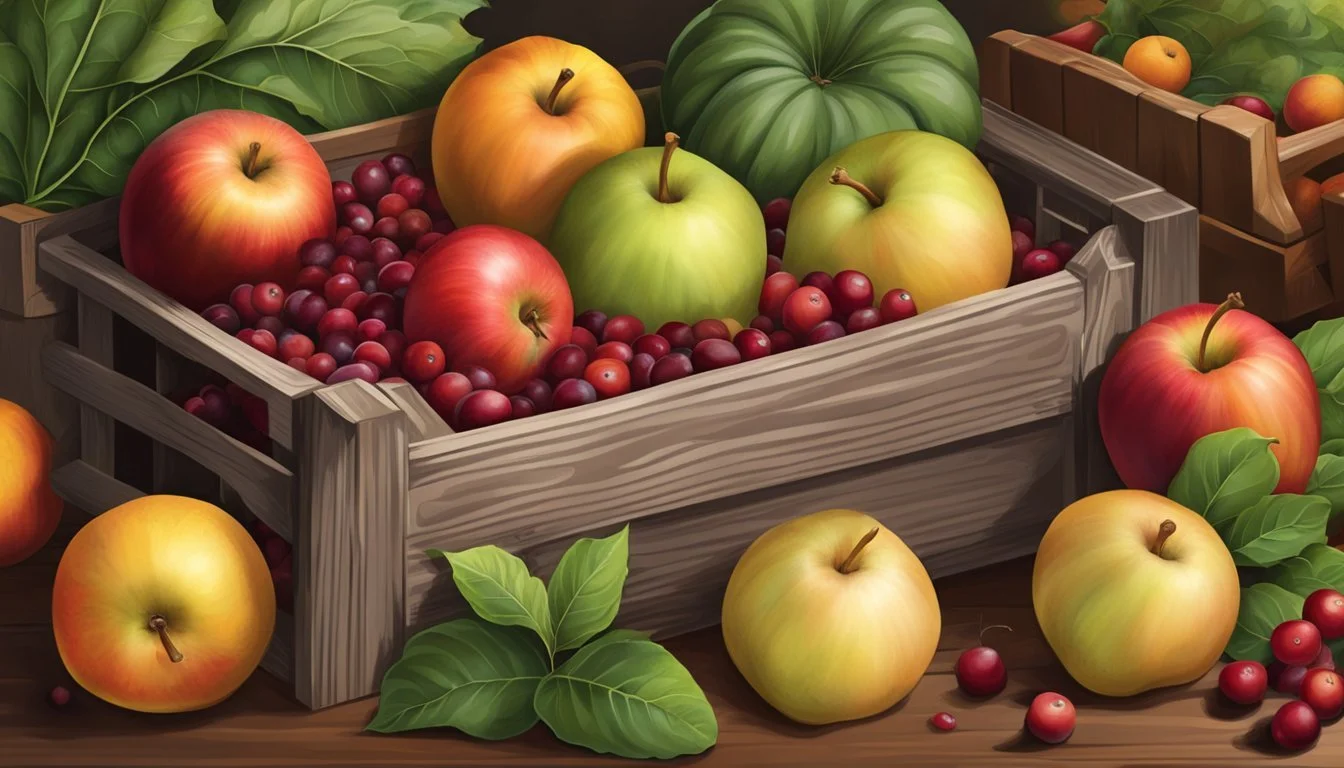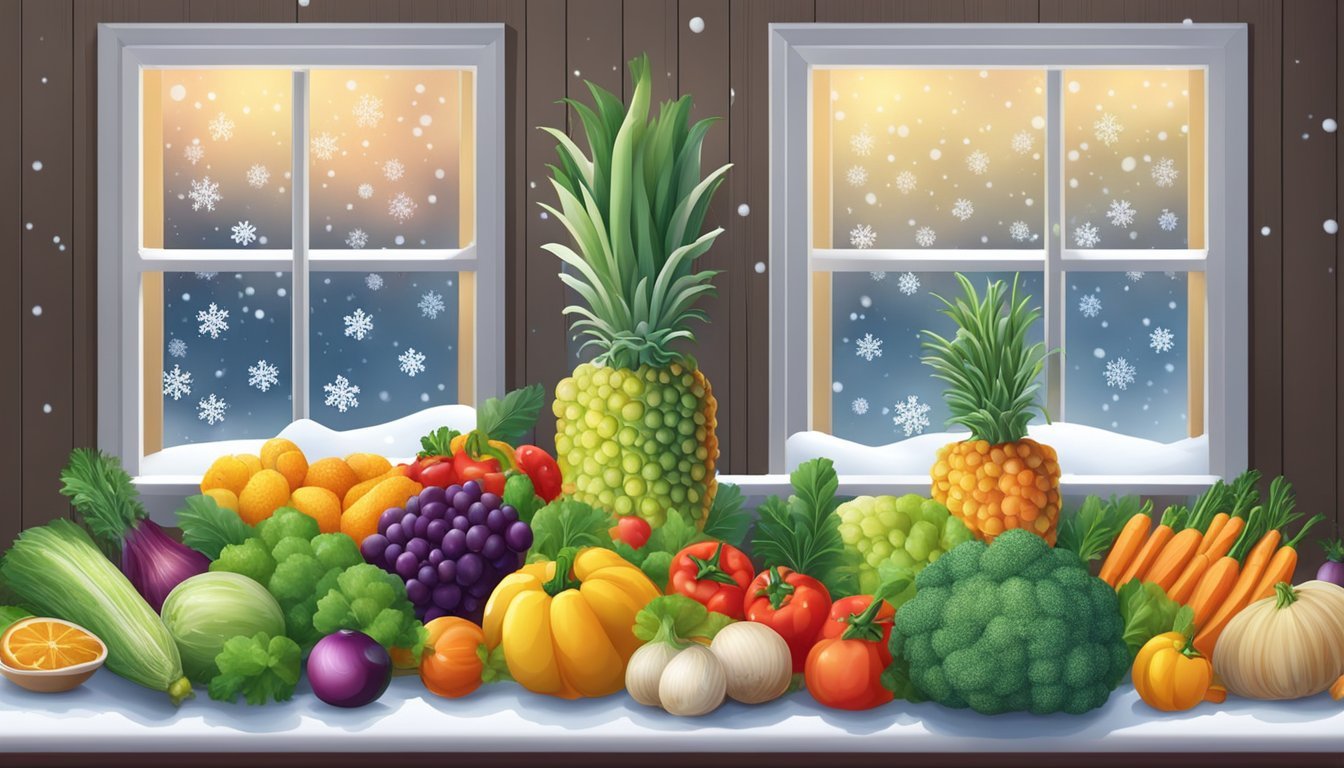Massachusetts Seasonal Fruit & Vegetables in December
Your Winter Produce Guide
This Article is Part of our Massachusetts Seasonal Fruit & Veg Calendar
December in Massachusetts marks a distinct shift in the local produce offerings as the state transitions deep into the winter season. The cold climate of the region dictates a limited availability of fresh fruits (What wine goes well with fruit?) and vegetables during this time. However, despite the chilly weather, consumers can still access a variety of seasonal produce that is harvested in the late fall and sold through the winter months.
The winter harvest is characteristic of sturdy vegetables and hardy greens that can withstand the frosty conditions. Root vegetables such as carrots and potatoes remain staples, with storage crops like onions and garlic also readily available. In terms of fruit, Massachusetts's local cranberry bogs deliver their tart berries, which are a classic ingredient in holiday dishes and festive decorations.
While the selection may not be as vast as the bountiful summer months, December’s produce in Massachusetts includes nutritious and flavorful options that can be enjoyed fresh or utilized in warming, winter recipes. This array of produce not only supports local farmers but also provides consumers with the opportunity to incorporate seasonally appropriate, fresh foods into their diets.
Seasonal Overview of December
December in Massachusetts marks a transition into deep winter conditions, affecting the types of produce available. The shorter days and colder temperatures result in a distinct selection of fruits and vegetables that are resilient in the face of frost.
Winter Climate Impact on Produce
The winter climate, characterized by its low temperatures and risks of frost, significantly influences the types of produce that can be cultivated outdoors. Farmers in Massachusetts employ various techniques to protect hardier crops, like winter squash and root vegetables, which can withstand some of the harsh conditions. Indoor farming methods, such as greenhouses, also allow for the growth of certain seasonal vegetables beyond their traditional outdoor growing season.
December's Harvest Calendar
In December, the Massachusetts harvest calendar typically features a variety of produce that thrives in cooler weather. The list below details common fruits and vegetables available during this time:
Winter Squash: Varieties such as butternut, acorn, and spaghetti squash are staple offerings.
Root Vegetables: These include carrots (how long do carrots last?), parsnips, and beets (how long do beets last?), which store well and are versatile in the kitchen.
Leafy Greens: Some hardy greens like kale can persist through frosty conditions.
Brassicas: Cabbages and Brussels sprouts (how long do brussels sprouts last?) are also in season, often sweetened by the frost.
Importance of Seasonality
Understanding seasonality is crucial when considering the environmental impact and nutritional value of produce. Seasonal eating ensures that one benefits from the freshest and most flavorful produce, while also supporting local agriculture and reducing the carbon footprint associated with long-distance transportation of goods. Consumers are encouraged to take advantage of the unique qualities that December's harvest has to offer in Massachusetts.
Nutritional Benefits of December Produce
December's harvest offers an array of produce that is not only fresh but also packed with nutrients essential for maintaining good health during the colder months.
Health Advantages of Seasonal Eating
Eating fruits and vegetables that are in season in Massachusetts during December provides benefits such as a higher content of vitamins and minerals due to the produce being harvested at its peak of ripeness. Produce like kale and Brussels sprouts are rich in vitamin C, which is vital for immune system function, and broccoli (how long does broccoli last?)rabe is an excellent source of vitamin A, important for eye health. These vegetables also tend to have a higher concentration of flavor and may potentially reduce the intake of contaminants that can be present in off-season, long-distance shipments.
Kale: A powerfully nutritious vegetable, high in vitamins A, C, and K.
Brussels sprouts: They are not only high in fiber but also rich in antioxidants.
Optimizing Nutrient Intake
Consuming the seasonal produce of Massachusetts in December allows for optimal nutrient intake as these items are likely to be fresher, having spent less time in transit from farm to table. Fresh produce retains more nutrients; for instance, fiber, crucial for digestive health, is abundant in rutabagas and carrots. These fresh vegetables from the local harvest also provide a variety of minerals like potassium, which supports heart health, and magnesium, which is important for bone health and energy production.
Carrots: Rich in beta-carotene (which the body converts to vitamin A) and fiber.
Rutabagas: Contain good amounts of potassium and manganese, offering a spectrum of minerals.
Eating seasonal produce from Massachusetts in December is not only a delightful experience for the palate but also a robust boost for the body's nutritional needs.
Highlighting December's Fruits
In Massachusetts, December may not seem like the peak time for a variety of fruits, but there are a few that are ripe and ready for consumption. The Commonwealth sees the best of citrus fruits, late-fall apple varieties, and utilizes the last of its cranberry harvest.
Citrus Fruits Peak Season
December marks a notable period for citrus fruits in Massachusetts, with imported clementines and oranges taking center stage. They are known for their sweet and tangy flavors, making them a popular choice during the winter season.
Clementines: Juicy and seedless, perfect for on-the-go snacking.
Oranges: Larger and packed with vitamin C, ideal for juicing or as a breakfast staple.
Apple Varieties in Late Fall
While the apple harvest generally begins in late summer, some apple varieties reach their peak in the later months:
Envy™: Renowned for their crunch and a balance of sweetness.
Fuji: Known for their dense flesh and long shelf life, Fuji apples are sweet and crisp.
Apples sustain their flavor and firmness well through December, providing a versatile fruit option for both fresh eating and baking.
Cranberries Harvest and Uses
The tartness of cranberries offers a unique flavor that's synonymous with the holiday season. Massachusetts' cranberry bogs have recently completed their harvest, and the fruit's fresh and dried forms are incorporated into a variety of dishes:
Fresh cranberries: Used in sauces and as a tangy addition to baked goods.
Dried cranberries (how long do dried cranberries last?): Often added to salads, cereals, and as a sweet snack.
Cranberries, with their bold red color and robust flavor, have become a staple in winter recipes and festive decorations.
Showcasing December's Vegetables
December in Massachusetts brings a display of hearty vegetables that can withstand the chill of New England’s winter. These include a variety of root vegetables, squashes, and leafy greens that are at their prime during this month.
Root Vegetables and Squashes
Root vegetables like beets, carrots, turnips, and celeriac thrive in cooler weather, offering a natural sweetness intensified by the cold soil. These staples store well and bring warmth to winter dishes.
Squashes, with their thick skins, are ideal for storage and use throughout December. Varieties such as butternut, acorn, and spaghetti squash are not only flavorful but also rich in nutrients.
Beets: Earthy and rich, excellent for roasting or boiling.
Carrots: Sweet and crisp, perfect for a variety of culinary uses.
Celeriac: A root with a delicate celery (how long does celery last?)-like flavor, suitable for mashes and soups.
Squash: Comes in many forms; all are versatile for both sweet and savory applications.
Green Leafy Vegetables
The darker, hardier greens such as kale and cabbage are robust enough to endure the frost, sometimes becoming even sweeter post-frost.
Kale: This nutrient-dense leafy green can be enjoyed raw in salads or cooked.
Cabbage: It can be used in slaws, or cooked to make comforting soups and stews.
Hearty Winter Vegetables
Hearty winter vegetables are characterized by their ability to hold up under lower temperatures. These include Brussels sprouts, cauliflower, broccoli, and celery—all known for their versatility and flavor.
Brussels Sprouts: Grow on a stalk, and are harvested into the winter, with a nutty, slightly sweet flavor.
Cauliflower: Ideal for roasting, turning deliciously crispy at the edges.
Broccoli: Offers a high Vitamin C content and is perfect steamed or stir-fried.
Celery: Often used in soups and stews, adds a fragrant aroma.
Onions: A foundational ingredient available year-round, they add depth to any winter dish.
Incorporating these seasonal vegetables into meals not only supports local agriculture but also ensures the freshest, most flavorful ingredients on the table.
Cooking and Preparation Tips
With the winter season, one can truly embrace the robust flavors of Massachusetts's seasonal produce. These simple yet effective cooking and preparation methods aim to enhance the natural tastes and nutritional value of December fruits and vegetables.
Best Methods for Winter Produce
Winter produce benefits tremendously from techniques that intensify their natural sweetness and earthiness. Roasted root vegetables, like carrots and sweet potatoes, caramelize in the oven, bringing out a depth of flavor that is especially comforting in colder weather. Winter squash can also be roasted to perfection for a hearty addition to any meal. For cruciferous vegetables such as broccoli and kale, blanching before sautéing helps maintain their vibrant color and reduces bitterness.
Roasting: 400°F for 30-45 minutes, until golden.
Blanching: Boil for 30 seconds, then plunge into ice water.
Incorporating Produce in Festive Meals
Seasonal produce can add both flavor and festivity to holiday dishes. Sweet potatoes can be mashed to create a flavorful base for a vegetarian quesadilla or baked into chips for a crunchy snack. Adding chunks of roasted vegetables (What wine goes well with roasted vegetables?) to stews and soups not only thickens the base but also gives a festive spin to traditional recipes. They incorporate a distinct, fresh taste that is both nutritional and comforting.
Stews: Simmer roasted vegetables for 20 minutes for full flavor absorption.
Soups: Add roasted roots at the end of cooking to maintain texture.
Raw vs. Cooked: Maximizing Flavors
The way one chooses to prepare fruits and vegetables can vastly affect their flavor and texture, making them versatile in a variety of dishes. While cooking can enhance sweetness and tenderness, serving some vegetables raw in salads preserves their crispness and provides a contrast in dishes typically heavy with cooked elements during the winter. Broccoli rabe, for instance, can be added raw to salads for a peppery bite or sautéed with garlic to mitigate its sharpness.
Salads: Use raw thinly-sliced root vegetables for added crunch.
Sautéed: A quick sauté with garlic brings out a milder taste in greens.
Finding Local Produce in Massachusetts
In Massachusetts, local produce availability peaks from late spring through early fall, yet even in December, consumers can find seasonal items sourced from regional farms. Here's how they can support local agriculture and find fresh produce during this time.
Farmers Markets and CSAs
Farmers Markets: Although many farmers markets in Massachusetts close for the winter, a few remain open with limited winter hours, providing a selection of cold-weather crops and stored produce like root vegetables. The Massachusetts Department of Agricultural Resources maintains an updated list of winter farmers markets.
Community Supported Agriculture (CSAs): Some farms offer seasonal CSA programs where members buy a share of the harvest and receive regular distributions of produce. Winter CSAs may include items like winter squash, potatoes, and hardy greens.
Grocery Stores and Organic Shops
Grocery Stores: Many Massachusetts grocery stores make it a point to stock local produce when available. During December, look for signage indicating “locally sourced” or “Massachusetts grown” on items such as apples and root vegetables.
Organic Shops: These specialty stores often prioritize local and seasonal products. Shoppers may find a selection of organic produce that's been grown in the state, including items such as carrots, beets, and winter greens.
Supporting Local Agriculture
Direct from Farms: Some farms in Massachusetts offer direct sales through farm stands or online orders, often providing the freshest options for seasonal produce.
Agriculture Programs: The Commonwealth supports local agriculture through programs like MassGrown, which connects consumers with local farm products.
By visiting farmers markets, participating in CSAs, shopping at grocery stores with a commitment to local farmers, or buying directly from farms, residents can access fresh, seasonal produce while supporting Massachusetts agriculture even in the colder months.
Seasonal Recipes and Pairings
In December, Massachusetts kitchens are brimming with the seasonal harvest, offering a plethora of options for creative and comforting dishes. Fresh, locally sourced fruits and vegetables are the cornerstones of vibrant holiday meals (What wine goes well with holiday meals?), nourishing soups, and diverse side dishes.
Holiday Dishes with December Produce
Holiday tables shine when featuring roasted root vegetables like turnips and rutabaga. Their earthy flavors deepen when roasted, providing a robust accompaniment to traditional meats. Dishes such as cranberry-glazed rutabaga or a turnip and potato gratin are not only full of flavor but are also visually appealing for any festive setting. Adding pomegranates lends a bright, sweet contrast to salads or as a garnish for desserts.
Warm Soups and Hearty Casseroles
As the temperatures drop, a comforting bowl of soup takes center stage. A blended parsnip and apple soup, with a hint of nutmeg (how long does nutmeg last?), offers a creamy texture and a sweet, nuanced flavor. Hearty casseroles, like a broccoli and cheese bake, integrate the best of winter's produce with warmth and satisfying richness. Broccoli and cheddar is a classic combination, delivering a balance of vegetable nutrients and indulgent taste.
Creative Salads and Side Dishes
In December, salads are far from bland. Incorporating seasonal fruits such as crisp apples in a kale and apple salad with a honey vinaigrette elevates the dish. The bitterness of the kale is cut by the sweetness of the apple, making for a refreshing side. Side dishes like sauteed Brussels sprouts with cranberries also provide a flavor-packed experience, combining the cruciferous vegetable's savory notes with the tangy fruit, resulting in a delightful balance of flavors and nutrition.
Planning for Upcoming Seasons
In Massachusetts, as winter wanes, growers and consumers alike prepare for the bounty of the seasons ahead. Planning and preservation are crucial for making the most of each season's produce.
Early Spring Gardening and Crop Selection
Gardeners in Massachusetts should start their early spring planning by considering which crops to plant for the upcoming April and May harvest. Crucial early-spring crops include:
Asparagus
Peas
Leafy greens such as spinach and arugula
The selection of crops during this time can set the tone for a successful harvest throughout the spring, summer, and fall. Utilizing local planting calendars can help ensure that planting times are optimized for each crop's success.
Winter Preservation Techniques
As the Massachusetts growing season concludes in the fall, preservation techniques become pivotal for extending the life of the harvest through the winter months. Effective methods that individuals can employ include:
Canning: Suitable for a wide array of fruits and vegetables.
Freezing: Ideal for preserving many summer crops such as berries, beans, and corn-on-the-cob.
Drying: A method that works well for herbs, some root vegetables, and fruits like apples.
Planning for preservation in December means having the necessary supplies on hand before the abundant summer and fall harvests. This foresight ensures that the flavors of warmer seasons can be enjoyed throughout the chilly winter.










